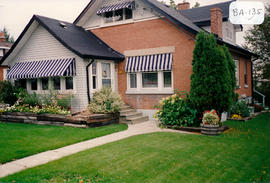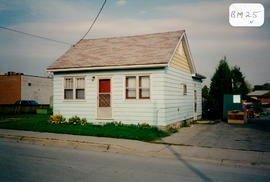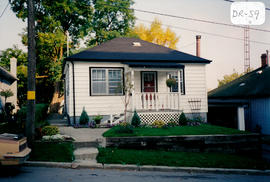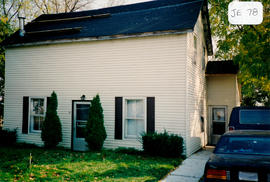135 Barrie Street - The Fred C. Cook House
- CA BWGPL GJ-HB-2017-03-12-06
- Pièce
- 1995
Fait partie de George Jackson fonds
The Fred C. Cook House is located mid-block on the east side at 135 Barrie Street. The house was built in the Arts and Crafts style around 1925 by Art Saint. It is believed that this lot was originally owned by Fred Stoddart. This was the home of Fred Cook and Leona (Miller) until they died after WWII. The house was later bought and remodeled by Gary and Rosemary Woodcock. He had a plumbing and heating business. Their son Gary Paul was a business partner.
The 1½-storey ‘bungalow’ has a simple form, an asymmetrical façade, and a rectilinear plan. A broad, steeply-pitched, bell-cast roof extends down to reduce the scale of the building. The covered, raised porch is entered from the side. The roof, horizontal siding, and a wide band of windows across the front of the porch emphasize the horizontal lines and massing of the style. Multiple, double-hung windows are set into wide, rectangular openings with high floor to ceiling heights on the ground floor. Smaller, second-storey windows are offset from the ground-floor windows and set into a gable and dormers. The lintels and lug sills are made of precast concrete. There is a parged, concrete foundation and wood frame construction with masonry cladding and vinyl siding. The original siding would have been wood. According to the 2000 inventory, the house is in excellent condition and the original features have been maintained well. It also notes that although the porch was enclosed sometime after the original construction, it is in keeping with the original design intent. (1, 2, 3)
Sans titre










